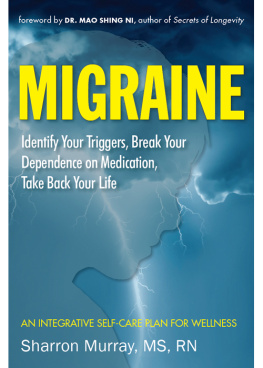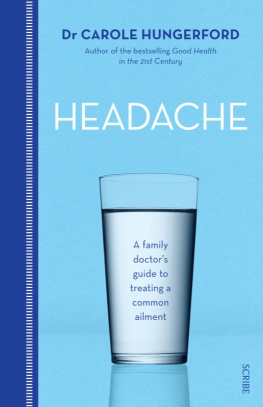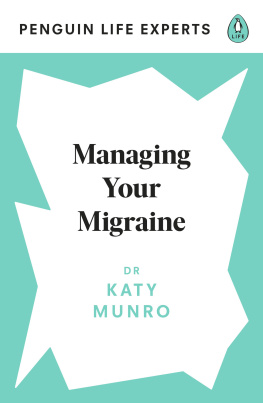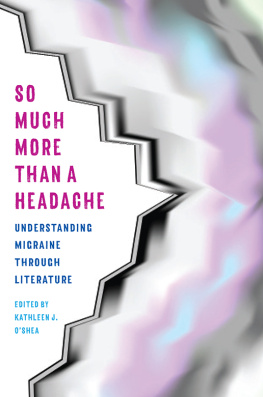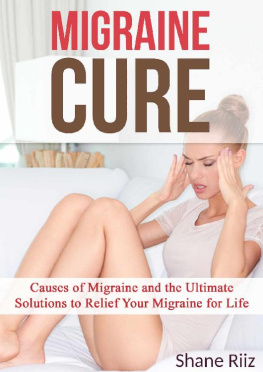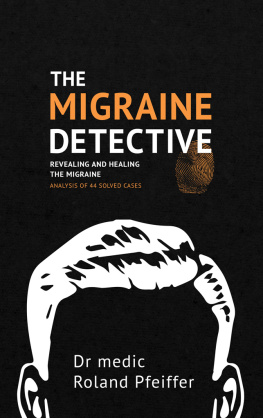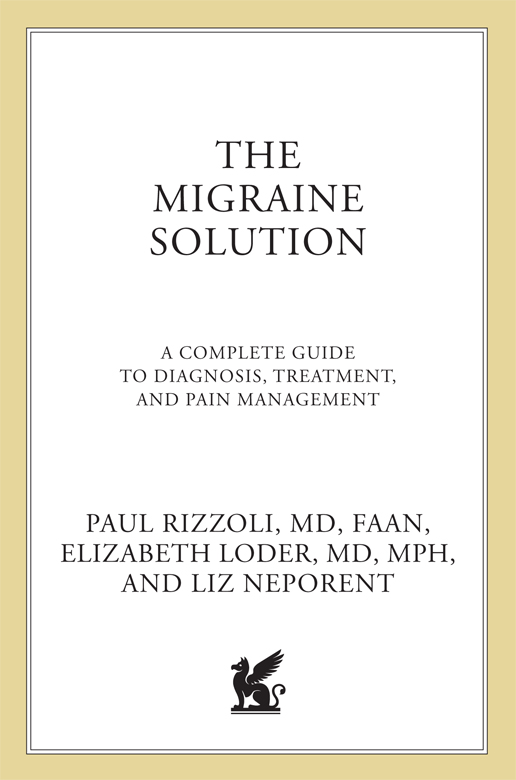
From ElizabethTo my father, Thomas Wentz
From PaulTo my father, Hugo; my uncle, Lewis; and my aunt, Lilia
From LizTo my brother Mark and his family
contents
Chapter 1
Chapter 2
Chapter 3
Chapter 4
Chapter 5
Chapter 6
Chapter 7
Chapter 8
Chapter 9
Chapter 10
Chapter 11
Chapter 12
Chapter 13
Chapter 14
chapter 1
What Are the Different Types of Headaches?
In the first season of the TV show Lost, Sawyer, one of the main characters, experienced headaches. What caused these headaches seemed to be an easily solved mystery: He needed reading glasses, which he managed to find on that mysterious island.
If only all headaches could be cured so quickly. But given the many colorful, bizarre, and even scary names that various types of headaches go by, its easy to be confused, or even terrified, by this common problem.
There are more than three hundred types of headaches listed in medical books though fewer than 10 percent have a known cause. Medical experts divide headaches into two general categories: primary and secondary.
Primary headaches arent the result of any underlying condition or disease; these headaches are self-contained. In other words, once weve arrived at a diagnosis, theres no testing necessary, and were ready to discuss treatment. Secondary headaches are the symptom of something else, typically a disease, trauma, or brain disorder. If we suspect a secondary cause, youll need to undergo testing to uncover the principal issue. Of the two, secondary headaches are more worrisome, but this in no way trivializes the pain and suffering someone with a primary headache experiences.
By the way, one frequent concern we often hear from patients is that their head pain moves around. This is actually a good sign. It typically means that there is a benign process at work, and it is almost always a manifestation of a primary headache. It is a reflection that the brain itself, rather than a lesion or an expanding tumor, is causing the problem.
How a Diagnosis Is Made
Making a diagnosis of a primary headache problem like migraines, tension-type, or cluster headaches is not just a matter of ruling out other causes of headache. The International Classification of Headache Disorders (ICHD), which is considered the bible for doctors who make headache diagnoses, lists criteria that must be met before a headache diagnosis can be assigned. ICHD classifies headaches based on their predominant characteristicsfor example, headaches that are one-sided with typical associated features such as nausea and vomiting generally fit in the migraine category. The different headaches may then be broken down into subtypes. Migraines, for instance, can occur with or without aura and can be episodic or chronic. Tension-type headaches can occur with or without muscle tension, and so on.
The ICHD headache categories and criteria were first developed based on the consensus of headache expertsheadache is a clinical diagnosis, and there are no tests or X-rays that prove someone has a migraine. Instead, the experts identified patterns of symptoms that are common in those with migraines. (This might help you understand why your doctor asks such detailed questions about your headache symptoms when trying to make a diagnosis.)
The ICHD is a work in progress and will undoubtedly be updated periodically in the future although we dont think its likely the criteria for migraines will change substantially. This is because the original criteria for diagnosing migraines and other disorders, such as cluster headaches, have stood the test of time quite well. Newer imaging techniques that allow us to see which parts of the brain are active during different types of headaches have in large part confirmed earlier expert opinion that these are two separate forms of headache.
Primary Headaches
Tension-type Headaches
Tension-type headaches are the most common type of headache, affecting more than three in four people at some point in their lives. We consider the term itself a misnomer because doctors dont believe that this type of headache is usually caused by muscle tension or stress. As a result, this is a very unsatisfactory and contested diagnosis. Many experts speculate that they are simply a milder form of migraines.
In our practice, we carefully explain the use of the diagnosis because it tends to carry a stigma. Mary came to us having been labeled a tension-headache sufferer several years ago, and one of the first things she told us is how much this bothered her. It makes me sound like I dont deal well with stress, and I cant get my act together, she said during her initial examination.
As we explained to Mary and tell all patients with a similar syndrome, the diagnosis is not a reflection on how they handle their lives. Tension-type headache refers simply to a pattern of headache, a fairly nondescript headache without many of the classic features of migraines. Unlike migraine headaches, tension-type headaches are not often accompanied by other symptoms, such as nausea, vomiting, or blurred vision. The pain is mild or moderate. It may envelop your entire head or be limited to the forehead or to the back or top of your head. Many people describe the sensation as a dull tightness or pressure that occurs in a bandlike pattern (see ). The intensity of the pain may fluctuate, but most of the time it wont be severe enough to keep you from functioning or sleeping or to awaken you at night.
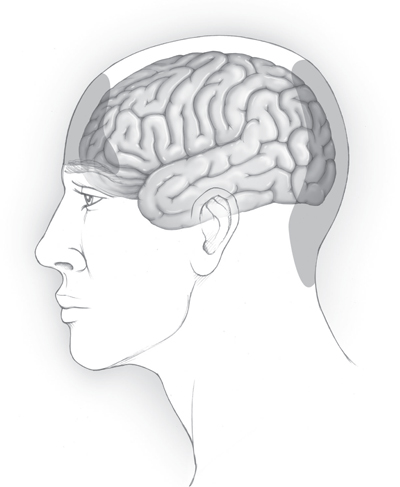
Figure 1: Tension-type headache pain
Tension-type headaches often produce steady pain across the forehead or in the back of the head. Sometimes, the pain is felt throughout the head, and the sensation is often described as a dull tightness.
Tension-type headaches can occur infrequently, regularly, or daily. They are common at any age, but women are more susceptible: Their lifetime prevalence is 88 percent, versus 68 percent for men. Really, anyone can have one. The patients we see tend to have the bad ones.
Cluster Headaches
When Jay described his headache episodes, they were understandably frightening. As he ticked off the symptoms, it quickly became clear he suffered from a rare but painful class of head pain known as cluster headaches.
Jays headaches begin suddenly, usually an hour or two after he falls asleep. The pain is intense, sharp, and penetrating, and it usually occurs behind one eye, which can get teary and bloodshot. His eyelid may droop, and the nostril on that side may first be stuffy, then runny. During a single attack, the symptoms can occur in either the left or right side but never in both.
Unlike someone with a migraine headachewho tends to lie quietly in bedJay must get up and pace the floor. The pain is so excruciating that its tempting to bang his head against a wall. After an hour or two, the pain and other symptoms usually recede, sometimes just as suddenly as they came on. But they tend to recur at the same time day after day.
About ten times as many men as women have cluster headaches. About 85 percent of those affected by this type of headache have the episodic form: clusters of one or two headaches a day over a period of two to six weeks, alternating with headache-free stretches. The remission time between cluster periods is generally six to twelve months, but it can be as short as a few weeks or as long as several years. The other 15 percent of those with cluster headaches have the chronic form. In these cases, the attacks continue for at least a year without any remission.



